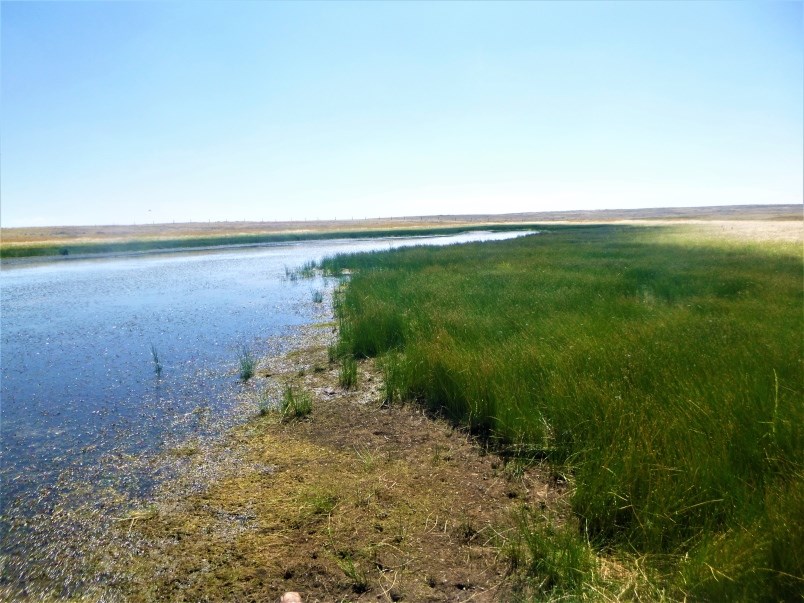A 40-acre research site planned to take shape near Saskatoon is expected to lead the way for a provincewide wetlands drainage policy.
The first step is building the site, set to begin this fall. Blake Weiseth, who is leading the project in the Langham area, said his team is to start collecting data in the spring.
Forty acres is about 1/57 the size of Regina’s Wascana Park. It will be called the Discovery Farm; Glacier Media is kicking in money to sponsor it.
“Our goal is to optimize land productivity by reclaiming marginally-productive, low-lying areas while preserving the ecological services within the landscape,” Weiseth said.
His team will do a two-year field study, analyzing, in part, how draining a wetland for farming affects the drained-soil area, and what happens when a wetland is drained from one area to another.
But any chance of borrowing ideas from Alberta’s or Manitoba’s wetlands drainage policies doesn’t seem likely.
“It may or may not be similar to what we see in Manitoba and Alberta. We're trying to establish what works in Saskatchewan … We're not going to copy Manitoba or Alberta, obviously,” Saskatchewan MLA Lyle Stewart said in a news conference on Tuesday.
“We want it to be based on science in our local conditions, and that's why we're doing this,” said Stewart, who’s the legislative secretary to Minister Responsible for the Water Security Agency (WSA) Greg Ottenbreit. The WSA is kicking in $1 million for the project.
University of Saskatchewan water researcher Christy Morrissey says this tunnel-vision type of attitude is common in wetlands drainage discussions across the three prairie provinces.
“These wetlands fall under provincial jurisdiction for implementing these policies, but there's not a lot of good crosstalk at different tables to kind of agree on that sentiment,” she said. “(Wetlands) are really being impacted by a lot of the same activities (across the provinces), largely agriculture … the threats are similar.”
She said it’s problematic “we still don't have a good system in place to get a more unified policy, which would be much stronger, much more impactful.”
Morrissey applauded the research farm and the work it will do, underscoring an urgent need for a clear policy in Saskatchewan.
She described Alberta’s policy as “fairly progressive, but not well-supported (here).”
It has a four-level grading system from low to high that determines the relative value of a given wetland. The policy allows for economic growth, minimizes “the loss and degradation of wetlands” and helps “make informed management decisions in the long-term interest of Albertans,” according to the government’s website.
It also sets its goal as “conserve, restore, protect and manage Alberta's wetlands to sustain the benefits they provide to the environment, society and economy.”
A landowner wishing to drain a wetland must seek regulatory approval from Alberta’s provincial government; they also have to justify why wetland impacts are unavoidable.
In Saskatchewan, a landowner needs to seek approval from the WSA office nearest them.
WSA spokesman Patrick Boyle said in an email, getting approval means obtaining “some form of land control, essentially permission, from those in downstream areas to a ‘Point of Adequate Outlet’ such as a creek, stream, river or other major waterbody that can carry the water without flooding on a frequent basis.”
He said the WSA started consulting with stakeholder groups in the fall to understand “water quantity, water quality and habitat” effects from wetlands drainage.
Morrissey says a policy here can’t come soon enough, stressing the removal of a wetland is detrimental to the environment, waterfowl, insects, and to farmers’ particular land plots.
“They provide flood control for farmers; they're preventing downstream runoff of excess nutrients (phosphorus and nitrogen) by retaining them in place on the landscape, so (there is) improved water quality downstream,” she said.
Her research also shows moving wetlands from one spot to another, or restoring them in previously drained areas, isn’t a quick fix.
“For it to become a natural wetland, it could take decades. Many of those functions we value for wetlands really can't easily be brought back by just plugging a drainage ditch.”




